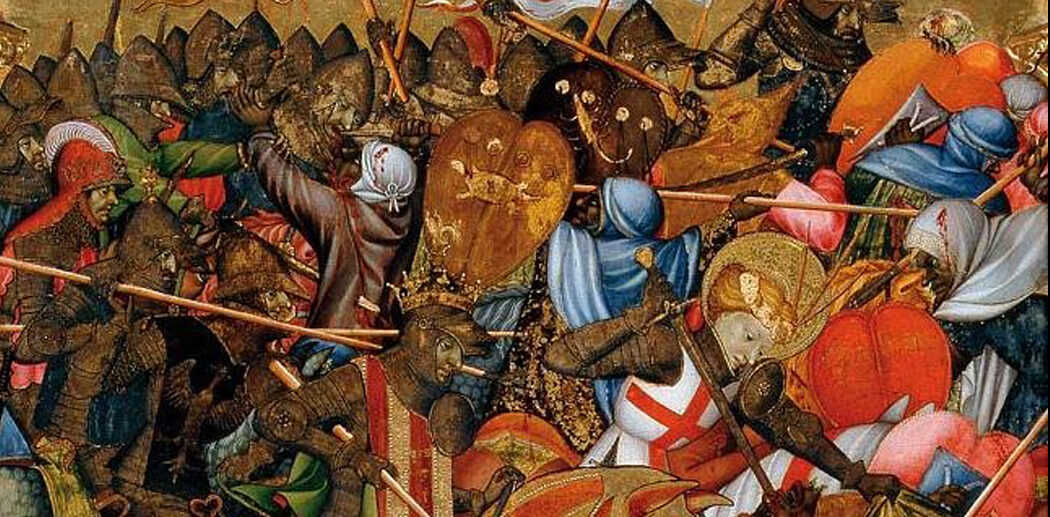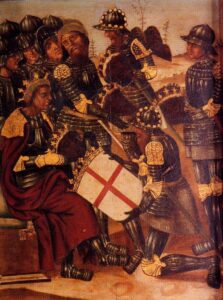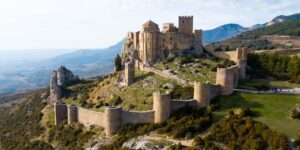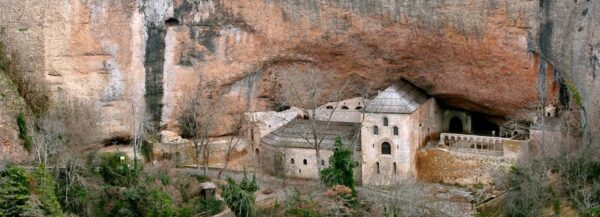Source:Historia de Aragón
The battle of Alcoraz marked a turning point in the Aragonese advance during the reconquest, allowing access to the Ebro valley and the retaking of the city of Huesca, which would be key to Aragonese expansion.
One of the most important events in the history of the Kingdom of Aragon took place in front of the walls of what they called “the city of the wall of a hundred towers”, which was none other than Wasqa, or as we know it, Huesca. Aragon, which was born as a small county nestled in the high valleys of the Pyrenees (like Sobrarbe and Ribagorza) and with all the limitations that this entailed, dreamed from the outset of wresting the territories of the plain, the Hoya de Huesca, from the Muslims. They had only a few valleys to devote to agriculture and livestock farming that provided little more than subsistence. Unlike what had happened in the Duero valley, which had been practically abandoned by the Muslims from very early on and which therefore facilitated an earlier advance, Islam was tremendously strong in the Ebro valley, and Wasqa and Saraqusta (Zaragoza) formed a formidable barrier that prevented the Christian advance.
However, on the death of Sancho III of Pamplona, the Aragonese county broke up and his son Ramiro took over the reins. Considered to be the first Aragonese king (although he never signed a document as such), he began a career of building a true state, providing it with structures and a capital, turning Jaca from little more than a hamlet into a city, and with its own army. Between him and, above all, his son Sancho Ramírez, Aragon became a regional power to be reckoned with, and while by 1035 it was barely able to defend its own borders and little else, in 1094 Sancho Ramírez laid siege to Wasqa. The misfortune of an unexpected arrow took him away from his destiny, but he made his sons swear that they would not rest until they had taken the city of Alto Aragon and the kingdom had finally managed to set foot firmly on the plain. And so his first-born son Pedro I did just that.
The conquest of Wasqa was thus an almost divine mission entrusted to the Aragonese monarchy, and its preparation lasted for decades. Imposing fortifications were built in the vicinity of the city, such as those of Loarre and Montearagón (from where the siege would be supported), first with the idea of defending the kingdom, but with a view to the future, to watch for Muslim movements and finally to be the bases from which to hold and finally strike the definitive blow.
After the failure of 1094, Peter I returned to the attack just two years later, and in June 1096 began the siege of the city, which was prepared to resist. Wasqa was a city belonging to the taifa of Saraqusta, and its king Al-Musta’in II began to prepare a large army, not only with the intention of lifting the siege and saving the city of Huesca, but also to deal the Christians such a blow that it would take decades for them to try to set foot on the plain again. The months passed and, finally, with the city already at the limits of its resistance, the taifa troops left the capital of the Ebro heading north. The chronicles say that this army was so large that its vanguard had already reached Zuera when the rearguard had not yet finished leaving Saraqusta. It is more than likely that this is an invention of the chroniclers, allowed by all to extol the Christian victory and that this was not the case, but it is certainly certain that King Al-Musta’in must have thrown almost all the forces of his kingdom into this battle, also counting on the help of Castilian troops under the command of Count García Ordóñez and Gonzalo Núñez de Lara sent by Alfonso VI, who had ambitions to conquer the Ebro valley and could not allow another Christian power to threaten and take over these territories.
On 15 November 1096, the two armies met face to face and began a fierce battle on the outskirts of Wasqa, in the so-called Alcoraz fields, which gave the battle its name. The fighting was fierce, but in the end, the Aragonese victory was total and, barely a week later, Pedro I and his troops entered Wasqa, which would be renamed Huesca, and which quickly became the new capital of the Aragonese kingdom. With the city also came control of the whole region and its fertile, rich and abundant lands, which finally consolidated the kingdom and gave it enough strength to take over Saraqusta itself, Tarazona, Calatayud, Daroca, etc. barely a quarter of a century later.
Chronicles from the 14th century, such as that of San Juan de la Peña, are the ones that relate Saint George to the battle of Alcoraz. The legend is very curious. It tells that there were two battles on the same day, in Antioch during the First Crusade and that of Alcoraz in Huesca, and that Saint George was in both. At Antioch he helped a German crusader who had lost his horse. The saint lifted him onto his horse and miraculously transferred him to Huesca. Once in Alcoraz, Saint George disappeared. As for the German warrior, believing that he was still in the first battle, he began to fight with the Muslims, although he did not know or understand any of those who were with him. Once the battle ended in victory for Peter I, the knight from Germany, who knew grammar – that is, he spoke Latin – managed to communicate with the Aragonese and everyone then realised that a great miracle had taken place, the protagonist of which was Saint George.
This legend is commemorated in Huesca in the hermitage of Saint George, located on the hill of the same name. There was a church dedicated to the saint there as early as the 13th century. The current chapel, which replaced it, was built in 1554. The Town Council of Huesca has been going there for centuries to celebrate the feast of St. George every 23rd April.
Share this article
On This Day
No Events
History of Spain
26 August 2020
27 January 2021
Communism: Now and Then
23 December 2022
28 July 2021









